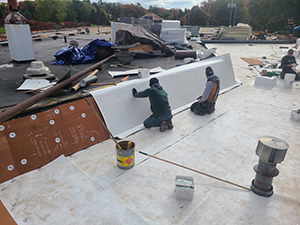
Rubber roofing is a popular choice for low-slope roofs due to its durability and cost-effectiveness. However, like all roofing materials, rubber roofs can develop issues over time that may lead to water damage if not properly addressed. Preventing water damage through proper maintenance and timely rubber roof repair is essential for extending the life of your rubber roof and avoiding costly interior damage.
Get the most from your Gypsum, CO area rubber roof by following good roofing management and partnering with Quality Cool Roof Solutions. Call 970-250-4582 to schedule your consultation.
Rubber Roof Management
Inspect Your Roof Regularly
Regular inspections are your first line of defense against water damage. Have your rubber roof professionally inspected at least twice a year, ideally in spring and fall, and after severe weather events. Monitor for signs of damage such as cracks, tears, blisters, or areas where the seams are separating. Also, check for pooling water, as standing water can accelerate deterioration.
Address Punctures and Tears Promptly
Small punctures and tears in rubber roofing can quickly lead to significant water intrusion if left unrepaired. Professional roofing contractors use specialized EPDM patching materials that include cleaner, primer, and self-adhesive patches to repair damaged areas. The repair process involves thoroughly cleaning the damaged area, applying primer, and installing a patch that extends beyond the tear in all directions.
Maintain and Repair Seams
Seams are vulnerable points in rubber roofing systems. Over time, the adhesive holding the seams together can deteriorate due to UV exposure and temperature fluctuations. Professional contractors can inspect all seams carefully during maintenance checks and apply appropriate seam adhesives specifically designed for rubber roofing when necessary.
Clear Debris Regularly
Leaves, branches, and other debris can trap moisture against your rubber roof, accelerating deterioration. Establish a routine for clearing debris, particularly around drains and scuppers, to ensure proper water drainage. Professional maintenance services can handle this task efficiently without risking damage to the membrane.
Prevent Ponding Water
Standing water, or ponding, can cause premature aging of rubber roofing materials. If your roof has low spots where water collects, professional roofers can install additional drains or adjust the roof slope. For minor ponding issues, tapered insulation can be added beneath the membrane to improve drainage.

Apply Roof Coatings
Protective coatings can extend the life of your rubber roof by providing an additional barrier against UV radiation and weathering. Professionals can apply acrylic or silicone roof coatings designed specifically for EPDM roofing to help prevent cracks and deterioration. These coatings should be reapplied every 5-10 years, depending on your climate and the manufacturer’s recommendations.
Schedule Professional Maintenance
Regular professional inspections and maintenance by qualified roofing contractors are essential. Professional roofers can identify potential problems before they lead to water damage and can perform complex repairs safely and effectively. An annual maintenance contract with a reputable roofing company ensures your rubber roof receives proper care throughout its lifespan.
Rubber Roof Repair Specialists
By following these preventative measures and addressing issues promptly through professional services, you can significantly extend the lifespan of your rubber roof and protect your property from costly water damage.
To learn more ways to get the highest ROI from your Gypsum, CO rubber roof investment, call 970-250-4582 and speak with one of our experts.
Frequently Asked Questions
How long does a rubber roof typically last?
With proper maintenance and professional care, a rubber roof can last 20-30 years. Regular inspections and timely repairs are crucial for maximizing lifespan.
How often should I have my rubber roof professionally inspected?
Professional inspections should be scheduled at least once per year, ideally in spring after winter weather has passed. Additional inspections after severe storms or extreme weather events are also recommended.
What are the signs that my rubber roof needs repair?
Warning signs include visible tears or punctures, bubbling or blistering of the membrane, separating seams, water stains on interior ceilings, and recurring leaks. Addressing these issues promptly can prevent more extensive damage.
Can a rubber roof be repaired in winter?
While emergency repairs can be performed in any season, comprehensive repairs and maintenance are best scheduled during warmer months when temperatures are above 40°F (4°C). This ensures proper adhesion of repair materials.
Is it worth applying a coating to an older rubber roof?
Yes, professional roof coatings can extend the life of an aging rubber roof by several years. These coatings provide additional protection against UV damage and weathering, potentially delaying the need for a full replacement.